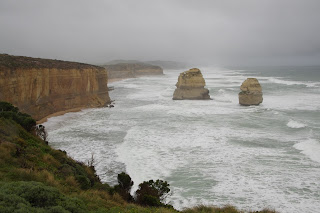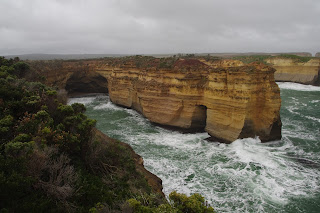 |
| Six (or seven) Apostles |
Our third day on the Great Ocean Road would be the most spectacular and weatherwise the most problematic. We enjoyed a few sunny moments, but it was mostly cloudy with a few torrential showers thrown in the the weather gods for our viewing pleasure. Even with the poor weather and at times lousy visibility this 25 mile section of the Great Ocean Road has to be easily one of the top two or three drives in the world.
 |
| Typical inland scenery |
Our drive today did begin with about 50 miles of inland travel. We actually started with a coupld of miles along the coast until we left Apollo Bay and then touched the coast once more at Castle Cove.
Once we hit the coastline again, we never traveled more than five miles without stopping for a look at something magnificent. Often these stops were to look a sea stacks, but other times we looked and small bays and inlets and a couple of bridges created by the massive waves that travel north from Antarctica across the Southern Ocean. As the waves batter the beautiful orange sandstone, they eat away at the rock first creating small inlets which become bridges and stacks before finally being completely beaten down and disappearing. The makes the coast for extremely hazardous for ships and during the days of sail, shipwrecks were a common occurrence.
 |
| Gibson Steps |
One special stop is Gibson Steps where you can walk down about 100 steps to the beach. Considering the weather we passed up this opportunity.
 |
| The Twelve get their own visitor center |
Shortly after Gibson Steps are the Twelve Apostles, probably the most famous and most photographed of all the highlights along the Great Ocean Road. They have been called Sow and Pigs or the Pinnacles in the past and when first named there were thirteen although Wikipedia says there were only nine. We are sure that the ninth one fell in 2005. Of varying sizes, we could see that the days are numbered for a couple more of them, while at the same time, we could see spots where more are being created. It’s just a matter of geologic time so these may not happen in our lifetimes.
 |
| More of the Twelve Apostles |
Shortly after the Twelve Apostles we stopped at Lord Ard Gorge named for the ship that wrecked here in 1878 with only two survivors. It could have been a great love story as the man who survived managed to pull the woman to shore with him. Unfortunately for the Cupid in all of us, she soon returned to England to be with what remained of her family while he stayed in Australia where he lived a long and successful life. Some of the dead are buried on the hill overlooking the Gorge.

 |
| Gorge pictures show new stacks being created |
 |
| The ocean is relentless |
Near to Lord Ard Gorge and its cemetery at the same stop is Mutton Bird Island. Mutton Bird is the local name for the Short-tailed Shearwaters who will be arriving in a few days from the Aleutians in the hundreds of thousands to breed all along the Aussie Coast. I did read that global warming is devastating their food in Alaska and there has been a large die-off. Scientists aren’t sure how many have died but thousands have been washing up on the shores of Alaska. Other seabirds are suffering a similar fate in Alaska as evidenced by the emaciated bodies washing up on shore.
 |
| Muttonbird Island |
London Bridge is another famous stop because of its history. Formerly it consisted of two arches connected to the mainland. The span closest to the mainline collapsed on 1990 leaving just the outer arch. Fortunately no one was on the arch when it collapsed, but the couple beyond it had to be airlifted to safety.
 |
| All fall down |
One of those torrential downpours caused us to bypass The Grotto for a bit as we headed to the end of the coastline at the Bay of Islands. It was still raining when we got there, but I still ventured out to the end of the trail through the stinging rain. I was glad I did because I had some of the best views of sea stacks close to the end of their lifespan and other spots where they are being created.


We made one stop on our way north to Ballarat at the Timboon Distillery. It had been recommended at the Information stop in Lorne as a good place to eat. We arrived at 4:30 just as it was closing. We did still get a tasting and a piece of caramel cake to tide us over until dinner in Ballarat two hours later. The folks there were fun and informative about the area and the liquor. We tried their whiskey, vodka, and limoncello. We would have purchased some, but we would too soon be on a plane to Cooper Pedy and its opal mines. We had dinner at the Daily Mail Hotel, one of the many pubs in Australia with hotel in the name but no rooms to let.
And some more pictures of this last day on the Great Ocean Road.














































No comments:
Post a Comment